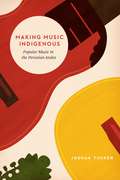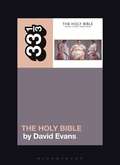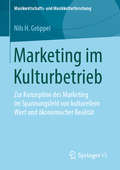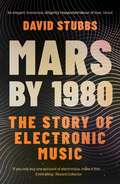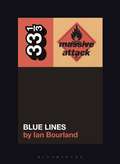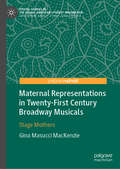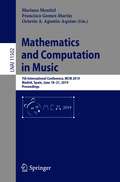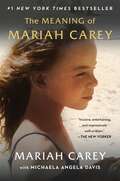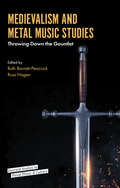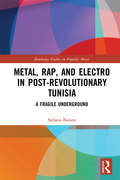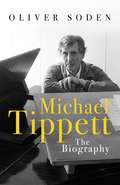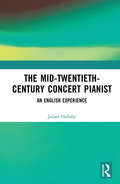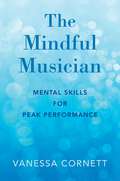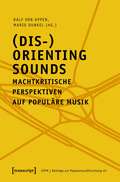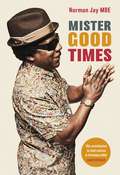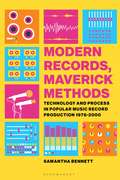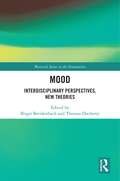- Table View
- List View
Making Music Indigenous: Popular Music in the Peruvian Andes (Chicago Studies in Ethnomusicology)
by Joshua TuckerWhen thinking of indigenous music, many people may imagine acoustic instruments and pastoral settings far removed from the whirl of modern life. But, in contemporary Peru, indigenous chimaycha music has become a wildly popular genre that is even heard in the nightclubs of Lima. In Making Music Indigenous, Joshua Tucker traces the history of this music and its key performers over fifty years to show that there is no single way to “sound indigenous.” The musicians Tucker follows make indigenous culture and identity visible in contemporary society by establishing a cultural and political presence for Peru’s indigenous peoples through activism, artisanship, and performance. This musical representation of indigeneity not only helps shape contemporary culture, it also provides a lens through which to reflect on the country’s past. Tucker argues that by following the musicians that have championed chimaycha music in its many forms, we can trace shifting meanings of indigeneity—and indeed, uncover the ways it is constructed, transformed, and ultimately recreated through music.
Making Music Indigenous: Popular Music in the Peruvian Andes (Chicago Studies in Ethnomusicology)
by Joshua TuckerWhen thinking of indigenous music, many people may imagine acoustic instruments and pastoral settings far removed from the whirl of modern life. But, in contemporary Peru, indigenous chimaycha music has become a wildly popular genre that is even heard in the nightclubs of Lima. In Making Music Indigenous, Joshua Tucker traces the history of this music and its key performers over fifty years to show that there is no single way to “sound indigenous.” The musicians Tucker follows make indigenous culture and identity visible in contemporary society by establishing a cultural and political presence for Peru’s indigenous peoples through activism, artisanship, and performance. This musical representation of indigeneity not only helps shape contemporary culture, it also provides a lens through which to reflect on the country’s past. Tucker argues that by following the musicians that have championed chimaycha music in its many forms, we can trace shifting meanings of indigeneity—and indeed, uncover the ways it is constructed, transformed, and ultimately recreated through music.
Making Music Indigenous: Popular Music in the Peruvian Andes (Chicago Studies in Ethnomusicology)
by Joshua TuckerWhen thinking of indigenous music, many people may imagine acoustic instruments and pastoral settings far removed from the whirl of modern life. But, in contemporary Peru, indigenous chimaycha music has become a wildly popular genre that is even heard in the nightclubs of Lima. In Making Music Indigenous, Joshua Tucker traces the history of this music and its key performers over fifty years to show that there is no single way to “sound indigenous.” The musicians Tucker follows make indigenous culture and identity visible in contemporary society by establishing a cultural and political presence for Peru’s indigenous peoples through activism, artisanship, and performance. This musical representation of indigeneity not only helps shape contemporary culture, it also provides a lens through which to reflect on the country’s past. Tucker argues that by following the musicians that have championed chimaycha music in its many forms, we can trace shifting meanings of indigeneity—and indeed, uncover the ways it is constructed, transformed, and ultimately recreated through music.
Making Music Indigenous: Popular Music in the Peruvian Andes (Chicago Studies in Ethnomusicology)
by Joshua TuckerWhen thinking of indigenous music, many people may imagine acoustic instruments and pastoral settings far removed from the whirl of modern life. But, in contemporary Peru, indigenous chimaycha music has become a wildly popular genre that is even heard in the nightclubs of Lima. In Making Music Indigenous, Joshua Tucker traces the history of this music and its key performers over fifty years to show that there is no single way to “sound indigenous.” The musicians Tucker follows make indigenous culture and identity visible in contemporary society by establishing a cultural and political presence for Peru’s indigenous peoples through activism, artisanship, and performance. This musical representation of indigeneity not only helps shape contemporary culture, it also provides a lens through which to reflect on the country’s past. Tucker argues that by following the musicians that have championed chimaycha music in its many forms, we can trace shifting meanings of indigeneity—and indeed, uncover the ways it is constructed, transformed, and ultimately recreated through music.
Making Music Indigenous: Popular Music in the Peruvian Andes (Chicago Studies in Ethnomusicology)
by Joshua TuckerWhen thinking of indigenous music, many people may imagine acoustic instruments and pastoral settings far removed from the whirl of modern life. But, in contemporary Peru, indigenous chimaycha music has become a wildly popular genre that is even heard in the nightclubs of Lima. In Making Music Indigenous, Joshua Tucker traces the history of this music and its key performers over fifty years to show that there is no single way to “sound indigenous.” The musicians Tucker follows make indigenous culture and identity visible in contemporary society by establishing a cultural and political presence for Peru’s indigenous peoples through activism, artisanship, and performance. This musical representation of indigeneity not only helps shape contemporary culture, it also provides a lens through which to reflect on the country’s past. Tucker argues that by following the musicians that have championed chimaycha music in its many forms, we can trace shifting meanings of indigeneity—and indeed, uncover the ways it is constructed, transformed, and ultimately recreated through music.
Manic Street Preachers’ The Holy Bible (33 1/3 #137)
by David EvansIn August 1994, Manic Street Preachers released The Holy Bible, a dark, fiercely intelligent album that explored such themes as mental illness, murder and war. Richey Edwards, the band's lyricist and motive force, vanished five months later; he was never found. In his absence The Holy Bible entered the rock canon alongside Joy Division's Closer and Nirvana's In Utero, the valedictory works of troubled young men. This book tells the dramatic story of Manic Street Preachers' masterpiece. Tracing the album's origins in the Valleys, an industrialised region of South Wales where the band spent their formative years, the author argues that The Holy Bible can be seen as a meditation on the uses and abuses of history.
Marketing im Kulturbetrieb: Zur Konzeption des Marketing im Spannungsfeld von kulturellem Wert und ökonomischer Realität (Musikwirtschafts- und Musikkulturforschung)
by Nils H. GröppelIn diesem Buch wird die Konzeption eines kulturbetriebsspezifischen Marketing vorgestellt. Sie verdichtet und systematisiert Aussagen über die Austauschprozesse im Kulturbetrieb und bietet damit interessierten Praktikern, Dozenten und Studierenden gleichermaßen Hilfestellungen. Dem Forschungsansatz der Kulturbetriebslehre folgend gilt es bei der Abhandlung die Wechselwirkung von symbolischer und ökonomischer Funktion von Kulturgütern zu berücksichtigen. So werden in einer sektoralen Annäherung, um der Simultanität und Interaktion der Funktionen Rechnung zu tragen, Gestalten und Merkmale der Kultur erörtert, die der Aufarbeitung der entsprechenden Austauschprozesse als Ansatzpunkte dienen. Darüber hinaus entwirft eine branchenspezifische Annäherung die Besonderheiten des „Marketing im Kulturbetrieb“ anhand einer Fallstudie zur Musikwirtschaft, die als institutioneller Rahmen der Vermarktung von kulturellen Symbolen (Musik bzw. Musikaufnahmen) genutzt wird.
Mars by 1980: The Story of Electronic Music
by David StubbsElectronic music is now ubiquitous, from mainstream pop hits to the furthest reaches of the avant garde. But how did we get here? In Mars by 1980, David Stubbs charts the evolution of synthesised tones, from the earliest mechanical experiments in the late nineteenth century, through the musique concrete of the Futurists and radical composers such as Pierre Schaeffer and Karl Stockhausen, to the gradual absorption of electronic instrumentation into the mainstream, be it through the BBC Radiophonic Workshop, grandiose prog rock or the DIY approach of electronica, house and techno.Stubbs tells a tale of mavericks and future dreamers, malfunctioning devices and sonic mayhem. But above all, he describes an essential story of authenticity: is this music? Mars by 1980 is the definitive account that answers this question.
Massive Attack’s Blue Lines (33 1/3 #140)
by Ian BourlandIn 1991, a loose-knit collective released a record called Blue Lines under the name Massive Attack, splicing together American hip-hop and soul with the sounds of the British underground. With its marauding bass lines, angular guitars, and psychedelic effects, Blue Lines built on the Caribbean soundsystems and nascent rave scene of the 1980s while also looking ahead to the group's signature blend of epic cinematics and lush downtempo. In the process, Blue Lines invented an entirely new genre called trip hop and launched the career of a rapper named Tricky.Ultimately, Blue Lines created the sonic playbook for an emerging future: hybrid, digital, cosmopolitan, and rooted in the black and immigrant communities who animated the urban wreckage of the postindustrial city. Massive Attack envisioned an alternate future in sharp counterpoint to the glossy triumphalism of Brit Pop. And while the group would go on to bigger things, this record was both a warning shot and a definitive statement that sounds as otherworldy today as on the day of its release. As Blue Lines's iconic flame logo spun on turntables the world over, Massive Attack and their spaced-out urban blues reimagined music for the 1990s and beyond.
Maternal Representations in Twenty-First Century Broadway Musicals: Stage Mothers (Pivotal Studies in the Global American Literary Imagination)
by Gina Masucci MacKenzieMaternal Representations in Twenty-First Century Broadway Musicals: Stage Mothers analyzes Broadway productions within the context of their presentation and assessment of motherhood and the variety of roles for mother figures. Using a frame of feminist and psychoanalytical positions, Gina MacKenzie establishes, defines, and interprets mother figures in contemporary Broadway, according to original categorizations of the absent, inconsequential, and overbearing mothers. MacKenzie considers how and why commercial representation of mother figures are limited and predominantly negative, even as fiction, poetry, and other forms of drama offer a much wider and progressive view of the varieties of motherhood possible in society, asserting the need for greater representation of mother figures in commercial musical theatre today.
Mathematics and Computation in Music: 7th International Conference, MCM 2019, Madrid, Spain, June 18–21, 2019, Proceedings (Lecture Notes in Computer Science #11502)
by Mariana Montiel Francisco Gomez-Martin Octavio A. Agustín-AquinoThis book constitutes the thoroughly refereed proceedings of the 7th International Conference on Mathematics and Computation in Music, MCM 2019, held in Madrid, Spain, in June 2019. The 22 full papers and 10 short papers presented were carefully reviewed and selected from 48 submissions. The papers feature research that combines mathematics or computation with music theory, music analysis, composition, and performance. They are organized in topical sections on algebraic and other abstract mathematical approaches to understanding musical objects; remanaging Riemann: mathematical music theory as “experimental philosophy”?; octave division; computer-based approaches to composition and score structuring; models for music cognition and beat tracking; pedagogy of mathematical music theory.The chapter “Distant Neighbors and Interscalar Contiguities” is available open access under a Creative Commons Attribution 4.0 International License via link.springer.com.
The Matter of Song in Early Modern England: Texts in and of the Air
by Katherine R. LarsonGiven the variety and richness of the sixteenth- and seventeenth-century English 'songscape', it might seem unsurprising to suggest that early modern song needs to be considered as sung. When a reader encounters a song in a sonnet sequence, a romance, and even a masque or a play, however, the tendency is to engage with it as poem rather than as musical performance. Opening up the notion of song from a performance-based perspective, The Matter of Song in Early Modern England considers the implications of reading song not simply as lyric text but as an embodied and gendered musical practice. Animating the traces of song preserved in physiological and philosophical commentaries, singing handbooks, poetic treatises, and literary texts ranging from Mary Sidney Herbert's Psalmes to John Milton's Comus, the book confronts song's ephemerality, its lexical and sonic capriciousness, and its airy substance. These features can resist critical analysis but were vital to song's affective workings in the early modern period. The volume foregrounds the need to attend much more closely to the embodied and musical dimensions of literary production and circulation in sixteenth- and seventeenth-century England. It also makes an important and timely contribution to our understanding of women's engagement with song as writers and as performers. A companion recording of fourteen songs featuring Larson (soprano) and Lucas Harris (lute) brings the project's innovative methodology and central case studies to life.
The Meaning of Mariah Carey
by Mariah CareyThe global icon, award-winning singer, songwriter, producer, actress, mother, daughter, sister, storyteller, and artist finally tells the unfiltered story of her life in The Meaning of Mariah Carey.It took me a lifetime to have the courage and the clarity to write my memoir. I want to tell the story of the moments - the ups and downs, the triumphs and traumas, the debacles and the dreams, that contributed to the person I am today. Though there have been countless stories about me throughout my career and very public personal life, it’s been impossible to communicate the complexities and depths of my experience in any single magazine article or a ten-minute television interview. And even then, my words were filtered through someone else’s lens, largely satisfying someone else’s assignment to define me.This book is composed of my memories, my mishaps, my struggles, my survival and my songs. Unfiltered. I went deep into my childhood and gave the scared little girl inside of me a big voice. I let the abandoned and ambitious adolescent have her say, and the betrayed and triumphant woman I became tell her side.Writing this memoir was incredibly hard, humbling and healing. My sincere hope is that you are moved to a new understanding, not only about me, but also about the resilience of the human spirit.Love,Mariah
Medievalism and Metal Music Studies: Throwing Down the Gauntlet (Emerald Studies in Metal Music and Culture)
by Ruth Barratt-Peacock Ross HagenMetal music has long nurtured an obsession with visions of the Middle Ages, with countless album covers and lyric sheets populated by Vikings, knights, wizards, and castles. Medievalism and Metal Music Studies: Throwing down the Gauntlet addresses this fascination with all things medieval, exploring how metal musicians and fans find inspiration both in authentically medieval materials and neomedievalist depictions of the period in literature, cinema, and other media. Within metal music, the medieval takes on multiple, and even contradictory meanings, becoming at once a cipher of difference and grotesque alterity while simultaneously being imagined as a simpler, more authentic time, as opposed to the complexities and stresses of modernity. In this fashion, the medieval period becomes both a source for artistic creativity and a vector for countercultural social and political critique. The contributors in this book hail from a wide range of fields including medieval history, music performance, musicology, media studies, and literature, and computer linguistics, bringing a variety of critical perspectives to bear on the topic. Engaging in analyses of cover art, liner notes, lyrics, and musical style, the contributors investigate issues of research methodologies, crucial concerns over identity and nationalism, and the recontextualisation of historical materials, all aimed at critically examining how and why medievalism has permeated heavy metal music and culture. Hearken to our tales!
Medievalism and Metal Music Studies: Throwing Down the Gauntlet (Emerald Studies in Metal Music and Culture)
by Ruth Barratt-Peacock Ross HagenMetal music has long nurtured an obsession with visions of the Middle Ages, with countless album covers and lyric sheets populated by Vikings, knights, wizards, and castles. Medievalism and Metal Music Studies: Throwing down the Gauntlet addresses this fascination with all things medieval, exploring how metal musicians and fans find inspiration both in authentically medieval materials and neomedievalist depictions of the period in literature, cinema, and other media. Within metal music, the medieval takes on multiple, and even contradictory meanings, becoming at once a cipher of difference and grotesque alterity while simultaneously being imagined as a simpler, more authentic time, as opposed to the complexities and stresses of modernity. In this fashion, the medieval period becomes both a source for artistic creativity and a vector for countercultural social and political critique. The contributors in this book hail from a wide range of fields including medieval history, music performance, musicology, media studies, and literature, and computer linguistics, bringing a variety of critical perspectives to bear on the topic. Engaging in analyses of cover art, liner notes, lyrics, and musical style, the contributors investigate issues of research methodologies, crucial concerns over identity and nationalism, and the recontextualisation of historical materials, all aimed at critically examining how and why medievalism has permeated heavy metal music and culture. Hearken to our tales!
Metal, Rap, and Electro in Post-Revolutionary Tunisia: A Fragile Underground (Routledge Studies in Popular Music)
by Stefano BaroneMetal, Rap, and Electro in Tunisia is a trip into the music scenes of Tunisia after the Arab Springs. Based on extensive field research, the book explores the social life of heavy metal, rap, and electronic music in a North African country whose mass revolution of 2010/2011 led the way to a troubled and yet unique democracy. What is it like to be part of a music scene in a place affected by poverty and inequality? How do the many conflicted souls of Tunisian Islam shape local metal, rap, and electro? What are the social and cultural stakes for music in a nation constantly represented as a bridge between Europe and the Middle East? How do music scenes articulate the complex political scenario that followed the Tunisian revolution of 2011? Barone answers these questions by offering new theoretical reflections on youth cultures and popular music in a global perspective, and thus pushing the debate on "post-subcultures" and scenes forward. At the same time, the book offers a dense sociological analysis of youth and music in reality - the Tunisian one - whose society, culture, religion, and politics are at stake in a historical transformation.
Metal, Rap, and Electro in Post-Revolutionary Tunisia: A Fragile Underground (Routledge Studies in Popular Music)
by Stefano BaroneMetal, Rap, and Electro in Tunisia is a trip into the music scenes of Tunisia after the Arab Springs. Based on extensive field research, the book explores the social life of heavy metal, rap, and electronic music in a North African country whose mass revolution of 2010/2011 led the way to a troubled and yet unique democracy. What is it like to be part of a music scene in a place affected by poverty and inequality? How do the many conflicted souls of Tunisian Islam shape local metal, rap, and electro? What are the social and cultural stakes for music in a nation constantly represented as a bridge between Europe and the Middle East? How do music scenes articulate the complex political scenario that followed the Tunisian revolution of 2011? Barone answers these questions by offering new theoretical reflections on youth cultures and popular music in a global perspective, and thus pushing the debate on "post-subcultures" and scenes forward. At the same time, the book offers a dense sociological analysis of youth and music in reality - the Tunisian one - whose society, culture, religion, and politics are at stake in a historical transformation.
Michael Tippett: The Biography
by Oliver Soden'A delight to read' Philip Pullman'Essential reading ... a genuine landmark publication' Tom ServiceA BBC Radio 4 'Book of the Week'The music of the British composer Michael Tippett - including the oratorio A Child of Our Time, five operas, and four symphonies - is among the most visionary of the twentieth century. But little has been written about his extraordinary life. In this long-awaited first biography, Oliver Soden weaves a century-spanning narrative of epic scope and penetrating insight.Soden has discovered troves of unpublished letters and manuscripts, and recorded moving interviews with Tippett's friends and colleagues. He paints a portrait of a powerful intellect and infectious personality: charming, stubborn, and great fun. But he also uncovers the sorrows and secrets that Tippett stowed away beneath his cheerfulness, not least the darker reaches of some tempestuous and often tragic love affairs. Soden's achievement is to have enriched our understanding not only of Tippett but of his times. Figures such as T.S. Eliot, E.M. Forster, Barbara Hepworth, and W.H. Auden jostle in the cast list. An Edwardian world of gaslight and empire cedes to turmoil and warfare; one startling revelation is the extent of Tippett's involvement in the fiery left-wing politics of the 1930s. The narrative roves from the mining villages of the north, blighted by unemployment, to a cell at Wormwood Scrubs, where Tippett was imprisoned as a conscientious objector. Later chapters uncover his operas' game-changing attitudes to gay and civil rights, against a backdrop of the Cold War and the Space Race. And singing from the page comes the music, through which Soden charts an exquisitely written course, offering lucid readings of Tippett's most famous works while resuscitating forgotten masterpieces. The result is a landmark in the study of twentieth-century culture, simultaneously an astonishing feat of scholarship and a story as enthralling as in any great novel.
The Mid-Twentieth-Century Concert Pianist: An English Experience
by Julian HellabyIn this book, Julian Hellaby presents a detailed study of English piano playing and career management as it was in the middle years of the twentieth century. Making regular comparisons with early twenty-first-century practice, the author examines career-launching mechanisms, such as auditions and competitions, and investigates available means of career sustenance, including artist management, publicity outlets, recital and concerto work, broadcasts, recordings and media reviews. Additionally, Hellaby considers whether a mid-twentieth-century school of English piano playing may be identified and, if so, whether it has lasted into the early decades of the twenty-first century. The author concludes with an appraisal of the state of English pianism in recent years and raises questions about its future. Drawing on extensive research from a wide variety of primary and secondary sources, this book is structured around case-studies of six pianists who were commencing and then developing their careers between approximately 1935 and 1970. The professional lives and playing styles of Malcolm Binns, Peter Katin, Moura Lympany, Denis Matthews, Valerie Tryon and David Wilde are examined, and telling comparisons are made between the state of affairs then and that of more recent times. Engagingly written, the book is likely to appeal to professional and amateur pianists, piano teachers, undergraduate and postgraduate music students, academics and anyone with an interest in the history of pianists, piano performance and music performance history in general.
The Mid-Twentieth-Century Concert Pianist: An English Experience
by Julian HellabyIn this book, Julian Hellaby presents a detailed study of English piano playing and career management as it was in the middle years of the twentieth century. Making regular comparisons with early twenty-first-century practice, the author examines career-launching mechanisms, such as auditions and competitions, and investigates available means of career sustenance, including artist management, publicity outlets, recital and concerto work, broadcasts, recordings and media reviews. Additionally, Hellaby considers whether a mid-twentieth-century school of English piano playing may be identified and, if so, whether it has lasted into the early decades of the twenty-first century. The author concludes with an appraisal of the state of English pianism in recent years and raises questions about its future. Drawing on extensive research from a wide variety of primary and secondary sources, this book is structured around case-studies of six pianists who were commencing and then developing their careers between approximately 1935 and 1970. The professional lives and playing styles of Malcolm Binns, Peter Katin, Moura Lympany, Denis Matthews, Valerie Tryon and David Wilde are examined, and telling comparisons are made between the state of affairs then and that of more recent times. Engagingly written, the book is likely to appeal to professional and amateur pianists, piano teachers, undergraduate and postgraduate music students, academics and anyone with an interest in the history of pianists, piano performance and music performance history in general.
MINDFUL MUSICIAN C: Mental Skills for Peak Performance
by Vanessa CornettIn The Mindful Musician: Mental Skills for Peak Performance, author Vanessa Cornett offers guidelines to help musicians cultivate artistic vision, objectivity, freedom, quiet awareness, and self-compassion, both on- and offstage in order to become more resilient performers. Contrary to modern culture's embrace of busyness and divided attention, Cornett's contemplative techniques provide greater space for artistic self-expression and satisfaction. With the aid of a companion website that includes audio files and downloadable templates, The Mindful Musician provides a method to promote attentional focus, self-assessment, emotional awareness, and creativity. The first of its kind to combine mindfulness practices with research in cognitive and sport psychology, this book helps musicians explore the roots of anxiety and other challenges related to performance, all through the deliberate focus of awareness.
**Missing** (Beiträge zur Popularmusikforschung #45)
by Ralf Von Appen Mario DunkelPopuläre Musik macht Angebote zur soziokulturellen Orientierung und Positionierung ihrer Hörer*innen. Damit verbunden sind Machtstrukturen - etwa im Verhältnis der Geschlechter, der Generationen, Ethnien oder sozialen Milieus -, die populäre Musik reproduzieren, aber auch aufbrechen kann, sodass Des- oder Neuorientierungen entstehen können. Die Beiträge dieses Bandes analysieren solche Prozesse kritisch und auf mehreren Ebenen: vom Neosexismus in Indie Rock und feministischen Gegenstrategien, über sexualisierte Afrika-Bilder und osteuropäische Hardbass-Szenen bis zum Entwurf posthumaner Welten in Videoclips. Darüber hinaus werden Leitvorstellungen der Musikpädagogik hinterfragt und Vorschläge für methodologische Neuorientierungen der wissenschaftlichen Auseinandersetzung mit populärer Musik formuliert.
Mister Good Times
by Norman JayTHE ENTHRALLING LIFE STORY OF THE LEGENDARY DJ, NORMAN JAY MBE 'Norman Jay's contribution to club culture is immeasurable . . . He brought new life to undiscovered classics and in doing so turned on a whole new generation' David RodiganMister Good Times is the enthralling story of a black kid growing up in a (largely white) working class world; of vivid, often violent experiences on the football terraces; of the emerging club scene growing out of a melting pot of styles; of how Jay, with his contemporaries, took the music of Black America, gave it a distinctly London twist, and used the marriage of styles to forge a hugely successful career as a trailblazing DJ and broadcaster, becoming an inspiration to a whole generation of dance music fans, black and white, without ever compromising his integrity.Along the way are tales of adventures across the country following Spurs; of Northern Soul nights, warehouse parties and illegal raves; of sound systems, the good and bad times of the Notting Hill carnival, the heady days of pirate radio, Rare Groove and the burgeoning British dance music scene.Mister Good Times is the story of a man who has lived his life on his own terms, helping to define a new British culture.
Modern Records, Maverick Methods: Technology and Process in Popular Music Record Production 1978-2000
by Samantha BennettFrom the Fairlight CMI through MIDI to the digital audio workstations at the turn of the millennium, Modern Records, Maverick Methods examines a critical period in commercial popular music record production: the transformative digital age from the late 1970s until 2000. Drawing on a discography of more than 300 recordings across pop, rock, hip hop, dance and alternative musics from artists such as the Beastie Boys, Madonna, U2 and Fatboy Slim, and extensive and exclusive ethnographic work with many world-renowned recordists, Modern Records presents a fresh and insightful new perspective on one of the most significant eras in commercial music record production.The book traces the development of significant music technologies through the 1980s and 1990s, revealing how changing attitudes and innovative techniques of recording personnel reimagined recording processes and, finally, exemplifies the impact of these technologies and techniques via six comprehensive tech-processual analyses. This meticulously researched and timely book reveals the complexity of recordists' responses to a technological landscape in flux.
Mood: Interdisciplinary Perspectives, New Theories (Warwick Series in the Humanities)
by Birgit Breidenbach Thomas DochertyMood is a phenomenon whose study is inherently interdisciplinary. While it has remained resistant to theorisation, it nonetheless has a substantial influence on art, politics and society. Since its practical omnipresence in every-day life renders it one of the most significant aspects of affect studies, it has garnered an increasing amount of critical attention in a number of disciplines across the humanities, sciences and social sciences in the past two decades. Mood: Interdisciplinary Perspectives, New Theories provides a comprehensive theoretical and empirical exploration of the phenomenon of mood from an interdisciplinary angle. Building on cutting-edge research in this emerging field and bringing together established and new voices, it bridges the existing disciplinary gap in the study of mood and further consolidates this phenomenon as a crucial concept in disciplinary and interdisciplinary study. By combining perspectives and concepts from the literary studies, philosophy, musicology, the social sciences, artistic practice and psychology, the volume does the complexity and richness of mood-related phenomena justice and benefits from the latent connections and synergies in different disciplinary approaches to the study of mood.
